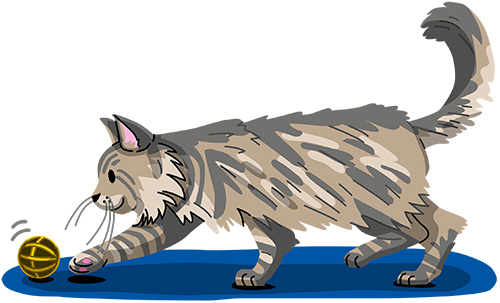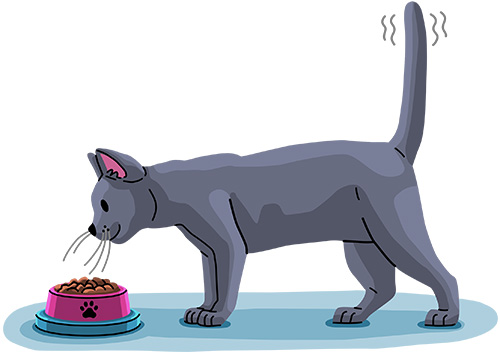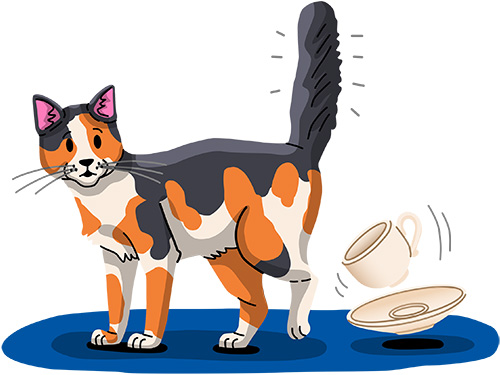Your cat’s tail can tell you a lot about how they’re feeling – if you know how to decipher the clues. Discover how to decode cat tail language and gain a better understanding of their moods and emotions.
Our cats express themselves in many ways, but it’s not always easy to understand what they’re saying. Cat body language can often be misinterpreted, so learning how to read your cat’s posture, including their tail movements, can help you better understand their moods and emotions.
Our cats’ wild ancestors lived solitary lives and mainly used scent to communicate. But as cats became domesticated, they learned to live alongside both people and other cats. At this point, visual signals such as tail movements became more important.
Here’s the explanations behind some common cat tail signals, and what they can tell you about how your cat is feeling.
Why do cats wag their tails?
What does it mean when a cat wags its tail? This tail movement can have a few different meanings, depending on the speed.
- Thrashing movements: If your cat’s tail is lashing from side to side, or even thumping on the ground, they’re probably agitated. This kind of strong movement signals strong emotions, and your cat may prefer to be left alone.
- Twitching movements: Cats sometimes twitch their tails when playing or hunting. But it can also be a sign of frustration and irritation.
When trying to work out what your cat’s tail wagging means, take note of the environment, your cat’s overall body language and vocalisations. Together, these can give you a clearer idea of what your cat is trying to tell you.

Why do cats swish their tails?
If your cat’s tail is gently swishing from side to side, they’re probably focused on something. That might be a toy, wildlife in the garden, or another cat! A swishing tail sometimes also accompanies natural stalking and pouncing behaviour.
Why do cats quiver their tail?
If you’re wondering ‘why does my cat’s tail vibrate?’, the answer is usually that your cat is excited about something. Whether that’s seeing you after a long day or looking forward to their breakfast, this tail movement is often accompanied by purrs and meows. Your cat might also rub themselves around your legs while quivering their tail.
However, a quivering tail can also be a sign of urine marking, which is a natural behaviour for both male and female cats.

Why do cats put their tails up?
One of the most commonly understood cat tail language signals is when they stick their tail straight up vertically. Sometimes, the end will be slightly curled, like a question mark. An upright tail position, with or without a curled end, lets other cats know they’re feeling friendly, confident and are ready to play or socialise. When your cat’s tail is up, it’s a good time to play or simply spend time together.
A straight up tail is also a sign of greeting used by kittens towards their mothers. Research from the University of Southampton (1997) demonstrated that most cats are happier to approach each other when their tails are raised compared to when their tails are lowered.
Why does my cat fluff their tail up?
A fluffed-up tail is a defensive reaction that usually means your cat has been startled by something, or is feeling threatened. By fluffing their tail up, they’re trying to appear larger. This tail movement might be triggered by loud noises, visitors, or sudden, unexpected movements.
Give your cat space and try to help your cat feel less stressed by removing whatever made them feel threatened.

Why do cats wrap their tails around their bodies?
When cats are lying down, they’ll sometimes wrap their tails around their bodies or tuck them underneath them. It may just be that they feel a bit chilly and want a cosy snooze, but sometimes a wrapped tail can signify stress and anxiety.
To decide what’s going on, consider the whole picture. Is your cat snuggled down with their nose tucked in on a chilly day? Or is their tail held awkwardly just above the ground, indicating tension? Are their eyes soft and relaxed, or wide open and aroused? Learn how to handle cat stress and anxiety here.
Why do cats put their tails down?
Cats sometimes keep their tails low to the ground when they’re feeling anxious or frightened. A tail tucked between their hind legs can also be a sign of discomfort or pain. In this case, ask your vet for advice.
Understanding your cat’s body language takes time, and it’s also important to consider breed-dependent differences in feline postures and behaviours. For instance, Persian cats often carry their tails lower than other breeds.
Every cat has their own body language quirks, but by paying close attention and respecting your cat’s preferences, you’ll soon be able to tell what those tail wags really mean!
Have you cracked the code to your cat’s tail movements? Head to our Facebook page.